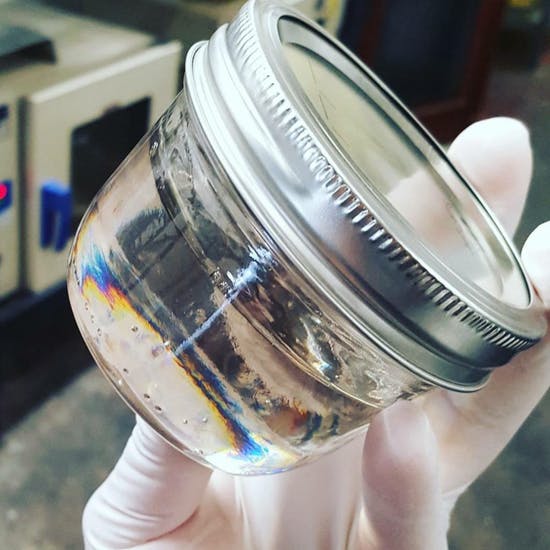What Is Delta-8-THC and How Is It Different from Delta-9?
2018-01-02
Cannabis is a flower that has grown naturally in the wild for thousands of years. It’s chocked full of chemical constituents–some of which are known as cannabinoids–that mesh with receptors throughout our body, eliciting a spectrum of mental and physical effects. THC or delta-9-tetrahydrocannabinol is by far the most well-known of these cannabinoids, but certainly isn’t the only powerful chemical compound native to the cannabis flower. Delta-8-THC, one of the four most common cannabinoids, is similar to its psychoactive relative THC, but with several key differences.

What Is Delta-8-THC?
According to the National Cancer Institute, delta-8-THC can be defined as:
“An analogue of tetrahydrocannabinol (THC) with antiemetic, anxiolytic, appetite-stimulating, analgesic, and neuroprotective properties. [Delta-8-THC] binds to the cannabinoid G-protein coupled receptor CB1, located in the central nervous system…This agent exhibits a lower psychotropic potency than [delta-9-THC], the primary form of THC found in cannabis.”
Delta-8-THC is chemically different from delta-9-THC by only a few atomic bonds and still offers a potent high of its own. While delta-8-THC only exists naturally in fractions of a percent, companies are finding value in concentrating esoteric cannabinoids for their unique effects and applications. Oleum Extracts, a top-tier cannabis extractor in Washington State, is currently producing an “AquaTek Delta-8 THC” distillate cartridge that demonstrates these properties.
For me, the AquaTek cartridge delivered a semisedative physical sensation without much whimsical mental stimulation. The distillate’s pervasive effects cascaded over my body while imbuing me with a classic “stoned” contentment. The appetite stimulation was apparent, but never fully manifested as hunger. This might be partially due to delta-8-THC’s anti-nausea qualities, however AquaTek does contain a modest amount of delta-9-THC as well.

I wanted to know more about how this distillate was made, what it was made of, and why, of all the cannabinoids, did Oleum pick delta-8-THC. To get the full story, I talked with Oleum’s CEO, Graham Jennings, and Senior Lab Specialist, Aaron Palmer.
Leafly: How is the delta-8-THC distillate made?
Oleum: This product is made by employing a thin film distillation–fractional distillation–of locally cultivated cannabis flower and trim. The isolation of the delta-8-THC compound in this process is accomplished through variations of temperature, vacuums, and scientific equipment to convert delta-9-THC over to delta-8-THC. This allows us to purify and isolate specific cannabinoids by removing any residual solvents, impurities, and any other undesirable compounds.
This yields the most potent and refined end-product that offers the user one of the most clean, potent and unique delta-8-THC products on the legal market today. Most dried cannabis flower contains less than 1% of delta-8-THC, so getting a product that contains a substantial amount of this cannabinoid can only be done through extraction, isolation, conversion, and refinement of dried cannabis flower. Our last batch of what we call AquaTek D8 Distillate, also known in the industry as Water Clear, tested at 58% delta-8-THC, 7.9% delta-9-THC, and 0.35% CBD.
How was the distillate’s cannabinoid ratio determined?
Oleum: The cannabinoid ratios in our delta-8 products are completely determined by the ratios found in the starting material of the specific strain of cannabis we choose to process. There are no preservatives or additives present in our distillates, just raw, unadulterated oil.
In this case, we used Lost Coast OG from Virginia Co. here in Washington State. This cultivator employs an aeroponic growing process that results in a well-flushed, premium end product ideal for extraction.
By keeping our delta-8 distillations strain-specific, we are able to record data and use that information in future extractions and processing to create identical or similar cannabinoid profiles and keep products consistent for our clients and consumers.
With over 100 cannabinoids available to isolate, why delta-8?
Oleum: Our passion has been and always will be cannabis extraction, processing, and refinement. Our goal is to refine and isolate as many cannabis compounds as we can–delta-8 just happened to catch our attention because of its novelty and potential benefits to the consumer.
What should consumers know about delta-8 THC?
Oleum: For one, delta-8-tetrahydrocannabinol has a lower psychotropic potency than its close cousin delta-9 THC, which is the most abundant cannabis constituent found in cannabis.
Second, it is known to connect to both CB1 and CB2 receptors in our bodies. A study was conducted in 1995 by Dr. Raphael Mechoulam in conjunction with Shaare Zedek Hospital, Bikur Holim Hospital, and Hebrew University in Jerusalem. In this study, delta-8 THC was administered to eight children ranging from 3 to 13 years of age with various hematologic cancers. These children had been treated with different drugs and [chemotherapy] for eight months prior to treatment with delta-8-THC. The delta-8-THC treatments started two hours before each session of chemo and continued every six hours for 24 hours. With this treatment, vomiting was completely prevented and side-effects were reported as negligible.
With the help of science, we too hope to influence and advance the benefits of delta-8-THC as well as all other cannabis-derived compounds.